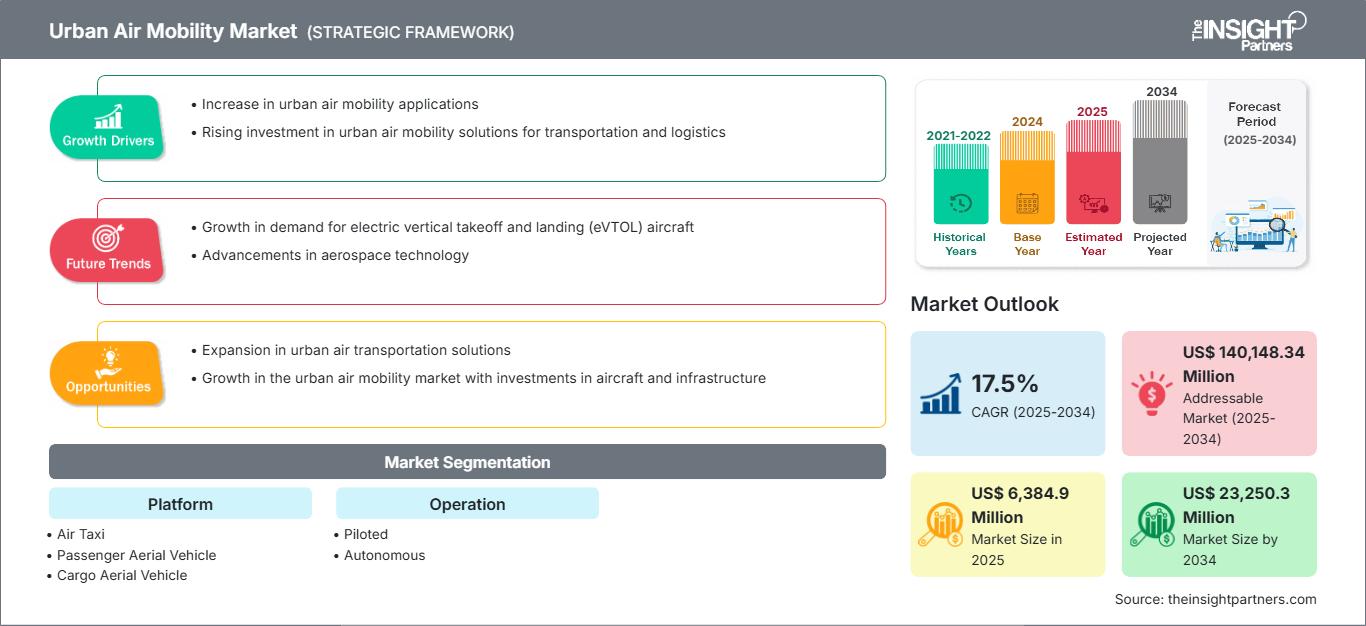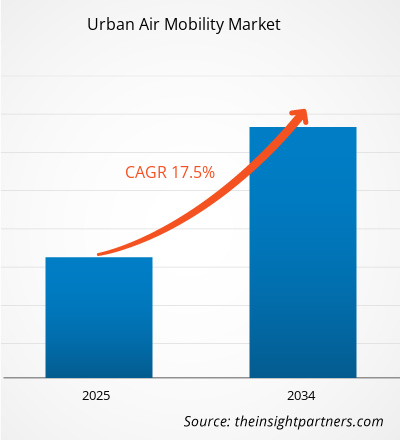Se espera que el mercado de movilidad aérea urbana alcance un valor de US$ 6.384,9 millones en 2025 y se proyecta que alcance los US$ 23.250,3 millones para 2034, y se espera que crezca a una CAGR del 17,5% durante el período de pronóstico de 2025 a 2034.
Un mínimo de tres y un máximo de cinco o seis pasajeros pueden viajar en transportadores de pasajeros de movilidad aérea urbana. En áreas rurales, más de seis pasajeros viajan en transportadores de pasajeros de tres ruedas según el requisito. El aumento de las congestiones de tráfico en las ciudades urbanas es un factor importante que impulsa el crecimiento del mercado. A medida que la población urbana mundial crece, la congestión del tráfico ha estado afectando seriamente la calidad de vida de las personas y afectando el crecimiento económico general. Por ejemplo, según INRIX (una empresa de análisis de tráfico), un viajero estadounidense pasa aproximadamente 41 horas en el tráfico cada año durante las horas pico de congestión. También mencionó que las congestiones de tráfico habían costado a los conductores estadounidenses aproximadamente US$ 305 mil millones en 2017, lo que implica un promedio de US$ 1,445 por conductor. Además, la Agencia de Protección Ambiental de EE. UU. estimó que un automóvil de pasajeros promedio emite 4.7 toneladas métricas de dióxido de carbono cada año. Además, los accidentes automovilísticos han aumentado, junto con el aumento de la propiedad de vehículos en países en desarrollo como India y China. Según la Organización Mundial de la Salud (OMS), aproximadamente 1,25 millones de personas mueren en accidentes de tráfico cada año, lo que supone unas 3400 muertes diarias. Esto no incluye los millones de heridos que se producen en accidentes no mortales.
El mercado global de la movilidad aérea urbana se segmenta por tipo en transporte de pasajeros y transporte de mercancías. Según el tipo de combustible, se divide en diésel, gasolina, GNC, GLP y eléctrico. La creciente demanda de movilidad aérea urbana eléctrica, el aumento de la población y la creciente necesidad de un vehículo que ayude a reducir la congestión vehicular en la región han impulsado el crecimiento del mercado global de la movilidad aérea urbana.
Obtendrá personalización en cualquier informe, sin cargo, incluidas partes de este informe o análisis a nivel de país, paquete de datos de Excel, así como también grandes ofertas y descuentos para empresas emergentes y universidades.
Mercado de movilidad aérea urbana: perspectivas estratégicas

-
Obtenga las principales tendencias clave del mercado de este informe.Esta muestra GRATUITA incluirá análisis de datos, desde tendencias del mercado hasta estimaciones y pronósticos.
Perspectivas del mercado de movilidad aérea urbana
Avances tecnológicos en aviación y conducción autónoma
Los avances en las tecnologías de aviación están creando el potencial para proporcionar transporte conveniente y eficiente a demanda para personas y carga en áreas metropolitanas. La Movilidad Aérea Urbana (MAU) es un concepto de transporte que tiene el potencial de reconstruir la movilidad social. Propone un transporte aéreo urbano altamente asequible, accesible y rápido, que reduciría la congestión terrestre al descargar la infraestructura vial existente. La MAU se basa en el avance de tecnologías como la propulsión eléctrica distribuida, nuevos modelos de negocio como los viajes compartidos basados en aplicaciones y tendencias en la fabricación aeroespacial avanzada que reducirán los costos de producción. Aumentar el crédito por la automatización de vehículos y las operaciones de vehículos autónomos será crucial para lograr la visión de la MAU autónoma. La autonomía será necesaria para un sistema de transporte económicamente viable capaz de satisfacer la alta demanda prevista. El aumento significativo en la madurez tecnológica de los vehículos estables, maniobrables, de despegue y aterrizaje vertical (VTOL), y el vuelo altamente automatizado impulsarán principalmente la industria de la MAU.
Información del mercado basada en plataformas
El mercado de la movilidad aérea urbana se divide, según su plataforma, en taxis aéreos, vehículos aéreos de pasajeros, vehículos aéreos de carga y ambulancias aéreas. Los UAM tienen una amplia gama de aplicaciones, lo que facilita el transporte rápido y sencillo de carga y personas. Estos UAM se utilizan ampliamente para el transporte de artículos pequeños, productos médicos y pasajeros. Sin embargo, estas soluciones de movilidad tienen sus propias limitaciones de vuelo según su uso. Los vehículos UAM no pueden volar a baja distancia, ya que impactarían contra edificios medianos y altos, ni a gran distancia, lo que podría afectar a cualquier aerolínea.
Perspectivas del mercado basadas en operaciones
El mercado de la movilidad aérea urbana se divide, según su funcionamiento, en piloto y autónomo. Se estima que el segmento autónomo liderará el mercado durante el período de pronóstico, ya que los eVTOL autónomos son más adecuados para el transporte de carga y pasajeros y se prevé que se utilicen cada vez más para el transporte interurbano.
Los actores del mercado de la movilidad aérea urbana se centran en estrategias como iniciativas de mercado, adquisiciones y lanzamientos de productos para mantener su posición en el mercado. Algunos avances de los actores clave del mercado son:
En febrero de 2020, Airbus y la Autoridad de Aviación Civil de Singapur firmaron un memorando de entendimiento para facilitar la movilidad aérea urbana en Singapur. Esta colaboración facilitaría la movilidad aérea urbana en el país.
En febrero de 2019, Airspace Experience Technologies firmó un acuerdo definitivo con Spirit AeroSystems para crear aviones de despegue y aterrizaje vertical (eVTOL) totalmente eléctricos certificados.
Perspectivas regionales del mercado de movilidad aérea urbana
Los analistas de The Insight Partners han explicado detalladamente las tendencias y los factores regionales que influyen en el mercado de la movilidad aérea urbana durante el período de pronóstico. Esta sección también analiza los segmentos y la geografía del mercado de la movilidad aérea urbana en América del Norte, Europa, Asia Pacífico, Oriente Medio y África, y América del Sur y Central.
Alcance del informe del mercado de movilidad aérea urbana
| Atributo del informe | Detalles |
|---|---|
| Tamaño del mercado en 2025 | US$ 6.384,9 millones |
| Tamaño del mercado en 2034 | US$ 23.250,3 millones |
| CAGR global (2025-2034) | 17,5% |
| Datos históricos | 2021-2022 |
| Período de pronóstico | 2025-2034 |
| Segmentos cubiertos |
Por plataforma
|
| Regiones y países cubiertos |
América del norte
|
| Líderes del mercado y perfiles de empresas clave |
|
Densidad de actores del mercado de movilidad aérea urbana: comprensión de su impacto en la dinámica empresarial
El mercado de la movilidad aérea urbana está creciendo rápidamente, impulsado por la creciente demanda de los usuarios finales debido a factores como la evolución de las preferencias de los consumidores, los avances tecnológicos y un mayor conocimiento de los beneficios del producto. A medida que aumenta la demanda, las empresas amplían su oferta, innovan para satisfacer las necesidades de los consumidores y aprovechan las tendencias emergentes, lo que impulsa aún más el crecimiento del mercado.

- Obtenga una descripción general de los principales actores clave del mercado de movilidad aérea urbana
Mercado de movilidad aérea urbana: por plataforma
- Taxi aéreo
- Vehículo aéreo de pasajeros
- Vehículo aéreo de carga
- Ambulancia aérea
Mercado de movilidad aérea urbana – por operación
- Pilotado
- Autónomo
Mercado de movilidad aérea urbana por geografía
-
América del norte
- A NOSOTROS
- Canadá
-
Europa
- Francia
- Alemania
- Reino Unido
- Rusia
- Resto de Europa
- Resto del mundo
Mercado de movilidad aérea urbana: perfiles de empresas
- Airbus SAS
- Ciencias del vuelo de la aurora
- Helicóptero Bell Textron Inc.
- EHang
- EmbraerX
- Honeywell International Inc.
- Kitty Hawk
- Moog Inc.
- Volocopter GmbH
- Análisis histórico (2 años), año base, pronóstico (7 años) con CAGR
- Análisis PEST y FODA
- Tamaño del mercado, valor/volumen: global, regional y nacional
- Industria y panorama competitivo
- Conjunto de datos de Excel
Informes recientes
Informes relacionados
Testimonios
Razón para comprar
- Toma de decisiones informada
- Comprensión de la dinámica del mercado
- Análisis competitivo
- Información sobre clientes
- Pronósticos del mercado
- Mitigación de riesgos
- Planificación estratégica
- Justificación de la inversión
- Identificación de mercados emergentes
- Mejora de las estrategias de marketing
- Impulso de la eficiencia operativa
- Alineación con las tendencias regulatorias






















 Obtenga una muestra gratuita para - Mercado de movilidad aérea urbana
Obtenga una muestra gratuita para - Mercado de movilidad aérea urbana